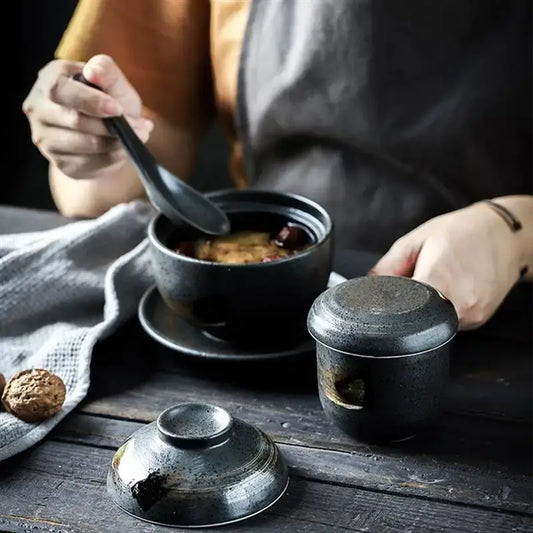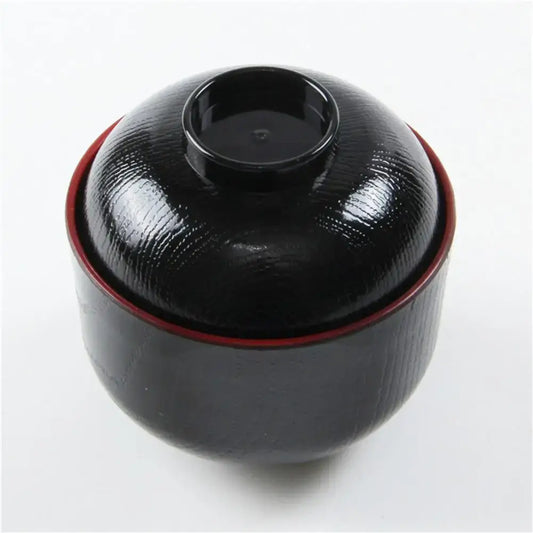The Heart of Japanese Dining: The Soulful Story of Miso Soup Bowls
Every meal tells a story, and in Japanese cuisine, that story often begins with a humble bowl of miso soup. Steam curls upward, carrying the aroma of umami and warmth, while the bowl cradling that comfort becomes a vessel of tradition. The miso soup bowl is not just a piece of tableware — it is a sacred symbol of balance, nourishment, and cultural artistry.
Crafted in countless forms — lacquered wood, ceramic, bamboo, or porcelain — miso soup bowls embody centuries of Japanese craftsmanship. They’re designed not only to hold warmth but to preserve harmony: between heat and hand, flavor and fragrance, beauty and purpose.
Every sip from a miso soup bowl connects you to a lineage that spans tea houses, family kitchens, and temple feasts. It’s where simplicity meets precision, and where even the smallest detail reflects respect for nature and for dining as an art form.
| Feature | Description | Why It Matters |
|---|---|---|
| Primary Material | Lacquered wood, ceramic, bamboo, or resin | Insulates heat and enhances aroma |
| Typical Size | 250ml – 500ml | Perfect single-serving portion |
| Design Origin | Japan (Edo and Meiji traditions) | Cultural authenticity |
| Temperature Resistance | High | Safe for hot broths and soups |
| Purpose | Serve miso soup, broths, and sides | Integral to Japanese meals |
A miso soup bowl is more than a dish. It’s a moment of mindfulness, a vessel of warmth, and a continuation of Japanese dining philosophy — that beauty lies in simplicity.
The Artistry Behind Miso Soup Bowls: Where Craft Meets Culture
Miso soup bowls have been crafted in Japan for over a thousand years, evolving alongside the nation’s culinary identity. Traditionally made from Japanese cypress (hinoki) or lacquered wood (urushi), each bowl was designed with dual intent — to be functional and to inspire reverence for the meal it contained.
The shape of a miso soup bowl is deliberate: a gentle curve that fits perfectly in the hand, a flared rim that releases just enough steam, and a balanced base that rests lightly yet securely. The tactile experience is part of the design — smooth, light, and inviting to hold.
The Traditional Process of Making Miso Soup Bowls
Japanese artisans still employ ancient methods that honor both the wood and the meal. The creation process can take days or even weeks:
-
Selection: Only fine-grained wood or clay is chosen for its heat resistance and texture.
-
Turning: Craftsmen use precision tools to shape the bowl into perfect symmetry.
-
Drying & Sanding: Each piece is air-dried, polished, and refined to reveal its natural grain.
-
Lacquering: Up to ten layers of natural urushi lacquer are applied for gloss and protection.
-
Decoration: Subtle patterns, gold leaf, or hand-painted motifs complete the piece.
| Stage | Method | Result |
|---|---|---|
| Selection | Choose durable, natural materials | Quality and longevity |
| Shaping | Turned or molded by hand | Balanced proportions |
| Lacquering | Multiple thin coats | Glossy, heat-resistant finish |
| Polishing | Hand-sanded | Smooth touch and shine |
| Detailing | Painted or engraved accents | Artistic individuality |
Every miso soup bowl embodies the Japanese principle of “shokunin kishitsu” — the craftsman’s spirit. It’s not mass production; it’s meditation in motion.
Why Miso Soup Bowls Are Awesome: A Union of Function and Feeling
The magic of a miso soup bowl lies not only in its appearance but also in its emotional and functional brilliance. It’s engineered with cultural empathy — every design choice rooted in centuries of wisdom about heat, comfort, and balance.
Perfect Thermal Harmony
Unlike glass or metal, traditional miso soup bowls are designed to retain warmth without burning the hand. The insulating material — whether natural lacquer or high-grade ceramic — keeps the broth hot while ensuring a gentle touch. The curve of the bowl helps preserve flavor layers, letting miso, tofu, and scallions mingle in balance.
| Functional Feature | Description | User Benefit |
|---|---|---|
| Heat-insulated design | Wood or lacquer prevents overheating | Safe to hold even when hot |
| Lightweight body | Average weight under 120g | Comfortable for one-hand use |
| Flared rim | Allows aroma release | Enhances taste experience |
| Non-porous finish | Prevents absorption of miso | Maintains hygiene and color |
| Balanced base | Steady yet elegant | Stable on tabletop |
Cultural Symbolism
Miso soup bowls represent connection and gratitude — the heart of Japanese dining culture. They are part of the ichiju-sansai tradition, meaning “one soup, three dishes,” emphasizing balance in both nutrition and aesthetics. Serving soup in a proper miso bowl transforms an everyday meal into a spiritual ritual of appreciation.
Sustainability Meets Longevity
Many modern miso bowls are crafted using eco-resin blends or bamboo composites, preserving traditional aesthetics while promoting environmental responsibility. This fusion of heritage and sustainability ensures that these bowls endure in both beauty and purpose.
How to Style Miso Soup Bowls: Turning a Meal into an Experience
Miso soup bowls can be styled far beyond their traditional roots. Their elegant curves, natural textures, and minimalist finishes make them ideal for modern homes that value cultural depth and visual serenity.
Traditional Japanese Aesthetic
Pair miso bowls with matching rice bowls, bamboo chopsticks, and wooden trays. Add shoji lighting or a linen placemat to recreate the calm of a Japanese tatami dining scene. The combination of warm lacquer and natural wood creates a setting that feels intimate and timeless.
Modern Minimalism
For contemporary kitchens, miso bowls in matte ceramics or monochrome lacquer finishes offer a sleek contrast to metallic utensils or stone countertops. Their simple silhouettes bring elegance without excess — a perfect embodiment of wabi-sabi minimalism.
Rustic and Bohemian Dining
In rustic or boho settings, mix miso bowls with handmade ceramics, raw wood boards, and neutral linens. Their organic charm pairs beautifully with earthy tones and artisanal textures, creating a feeling of grounded authenticity.
| Design Theme | Complementary Elements | Mood Created |
|---|---|---|
| Traditional | Lacquer tray, chopsticks, miso pot | Calm, cultural reverence |
| Modern Minimalist | Matte black plates, linen napkins | Elegant simplicity |
| Rustic | Wooden board, neutral ceramics | Warm and organic |
| Bohemian | Patterned napkins, eclectic ceramics | Artistic and soulful |
| Zen-inspired | Bamboo mats, white porcelain | Pure and meditative |
The key to styling miso soup bowls is balance — of texture, color, and cultural contrast. Let the bowl be both a vessel and a visual poem.
Perfect Pairings: Complementing Miso Soup Bowls with Other Tableware
Miso soup bowls flourish when surrounded by items that echo their aesthetic and function. Together, they create a complete Japanese dining ecosystem — graceful, harmonious, and deeply sensory.
Pairing with Tableware Essentials
| Item | Purpose | Aesthetic Effect |
|---|---|---|
| Rice bowl | Serves side rice | Traditional dining balance |
| Chopsticks | Completes the meal ritual | Cultural authenticity |
| Bamboo tray | Organizes set beautifully | Visual order and warmth |
| Ceramic sake cup | Adds ceremonial touch | Complements color palette |
| Small condiment dish | For pickles or soy sauce | Textural variation |
Pairing with Materials and Textures
Miso soup bowls pair beautifully with other natural materials, each enhancing a different dining experience.
| Material | Visual Contrast | Vibe Created |
|---|---|---|
| Bamboo | Light and natural | Organic harmony |
| Ceramic | Subtle and classic | Balanced tradition |
| Porcelain | Smooth and glossy | Modern refinement |
| Stoneware | Rough and earthy | Rustic character |
| Glass | Cool and minimal | Contemporary fusion |
Pairing with Cuisine and Moments
Beyond miso soup, these bowls can serve multiple culinary experiences — rice porridge, soba broth, desserts, or even matcha. Their versatility transforms them from kitchenware to cultural canvas.
| Dish Type | Recommended Bowl Finish | Presentation Style |
|---|---|---|
| Miso soup | Lacquered red or black | Classic Japanese dining |
| Ramen broth | Ceramic matte | Deep and cozy |
| Tofu or chawanmushi | Porcelain white | Elegant contrast |
| Matcha dessert | Textured bamboo | Earthy and inviting |
| Asian fusion soups | Glazed stoneware | Contemporary twist |
When styled thoughtfully, miso soup bowls become the centerpiece of every meal — simple yet profoundly expressive.
The Essence of Warmth: Closing Reflections on Miso Soup Bowls
At their heart, miso soup bowls represent more than culinary tradition — they encapsulate the soul of Japanese hospitality, omotenashi. They remind us that every meal is an act of mindfulness and every vessel a carrier of intention.
These bowls stand as silent teachers in a hurried world. They encourage you to slow down, hold warmth gently in your palms, and savor the fleeting beauty of the moment. Whether lacquered in timeless black, glazed in earthen tones, or molded from modern bamboo fiber, each miso soup bowl is a harmony of culture, craftsmanship, and care.
Owning one is not just a design choice; it’s a philosophy. It’s choosing substance over speed, simplicity over excess, and connection over consumption.
| Final Highlights | Key Takeaway |
|---|---|
| Cultural Heritage | Rooted in centuries of Japanese artistry |
| Eco-Friendly Design | Made from natural and renewable materials |
| Thermal Balance | Keeps soups warm, hands cool |
| Versatile Aesthetics | Fits traditional and modern homes alike |
| Mindful Dining | Encourages slow, intentional meals |
A miso soup bowl is a vessel of serenity — a tangible reminder that even the smallest act of eating can become a ritual of gratitude.
So the next time you cradle one in your hands, remember: you’re not just holding soup.
You’re holding a story — steeped in warmth, wisdom, and wonder.









